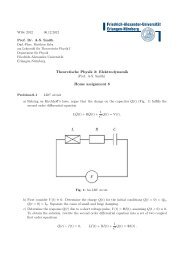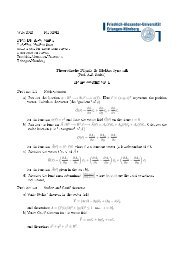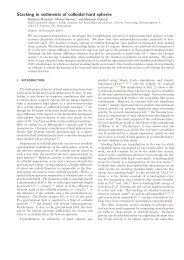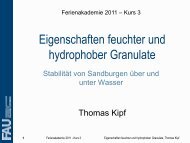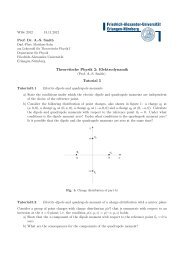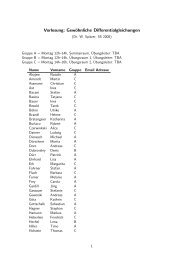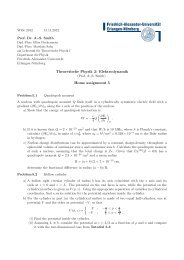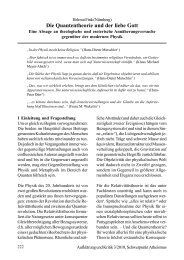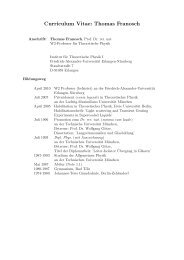Theoretische Physik 2: Elektrodynamik Tutorial 2 - Institut für ...
Theoretische Physik 2: Elektrodynamik Tutorial 2 - Institut für ...
Theoretische Physik 2: Elektrodynamik Tutorial 2 - Institut für ...
You also want an ePaper? Increase the reach of your titles
YUMPU automatically turns print PDFs into web optimized ePapers that Google loves.
WiSe 2012 23.10.2012<br />
Prof. Dr. A.-S. Smith<br />
Dipl.-Phys. Ellen Fischermeier<br />
Dipl.-Phys. Matthias Saba<br />
am Lehrstuhl für <strong>Theoretische</strong> <strong>Physik</strong> I<br />
Department für <strong>Physik</strong><br />
Friedrich-Alexander-Universität<br />
Erlangen-Nürnberg<br />
<strong>Theoretische</strong> <strong>Physik</strong> 2: <strong>Elektrodynamik</strong><br />
(Prof. A.-S. Smith)<br />
<strong>Tutorial</strong> 2<br />
<strong>Tutorial</strong> 2.1 Differential operators in cylindrical coordinates<br />
In cartesian coordinates the nabla operator is defined as follows:<br />
∂<br />
⃗∇ = ⃗e x<br />
∂x + ⃗e ∂<br />
y<br />
∂y + ⃗e ∂<br />
z<br />
∂z<br />
Cylindrical coordinates (ρ, φ, z) are defined as follows:<br />
x = ρ cos φ, y = ρ sin φ, z = z<br />
a) Transform the nabla operator into cylindrical coordinates. Proceed with the following steps:<br />
• Use the chain rule to write the partial derivatives ∂/∂x, ∂/∂y and ∂/∂z in terms of ∂/∂ρ,<br />
∂/∂φ, ∂/∂z<br />
• Write ⃗e x , ⃗e y and ⃗e z in terms of ⃗e ρ , ⃗e φ , ⃗e z<br />
Result: ∇ ⃗ ∂<br />
= ⃗e ρ ∂ρ + ⃗e φ 1 ∂<br />
ρ ∂φ + ⃗e z ∂ ∂z<br />
b) Calculate for a vector field A ⃗ the expression ∇ ⃗ · ⃗A<br />
Result: ∇ ⃗ · ⃗A = 1 ∂<br />
ρ ∂ρ (ρA ρ) + 1 ∂<br />
ρ ∂φ (A φ) + ∂ ∂z (A z)<br />
<strong>Tutorial</strong> 2.2<br />
Newton’s theorem<br />
a) Prove the electrostatic analog of Newton’s theorem:<br />
For a spherically symmetric charge (or mass, in the case of gravity) distribution ρ(r),<br />
the radial component of the electric field, E r = E ⃗ · ⃗r/r, is given by<br />
E r = Q(r)<br />
r 2 with Q(r) = 4π<br />
∫ r<br />
0<br />
ρ(R)R 2 dR ,<br />
i. e. the same as if the charge in the sphere of radius R is located at the center of the<br />
sphere.
Calculate also the associated electrostatic potential.<br />
Note that the Poisson equation in spherical coordinates reads<br />
−4πρ = ∇ 2 ϕ = 1 (<br />
∂<br />
r 2 r 2 ∂ϕ )<br />
1 ∂<br />
+<br />
∂r ∂r r 2 sin ϑ ∂ϑ<br />
(<br />
sin ϑ ∂ϕ<br />
∂ϑ<br />
)<br />
+<br />
1 ∂ 2 ϕ<br />
r 2 sin 2 ϑ ∂φ 2 .<br />
b) As an application of Newton’s theorem, consider a charge-free spherical cavity concentric with<br />
the center of a spherically symmetric charge distribution. What is the electric force on a test<br />
charge inside this hole?<br />
<strong>Tutorial</strong> 2.3<br />
Stable rest position in an electrostatic field<br />
Consider a time-independent electric field ⃗ E(⃗x) with the property that for a point particle with charge<br />
q > 0 the position ⃗x = 0 is a stable rest position with a linear reset force. That is, for the force ⃗ F = q ⃗ E,<br />
the following properties hold:<br />
• ⃗ F is zero at ⃗x = 0.<br />
• In the vicinity of ⃗x = 0 ⃗ F forces the particle back to ⃗x = 0. ⃗ F (⃗x) can be regarded as a linear<br />
function of ⃗x for small displacements.<br />
The magnetic field is zero.<br />
Show that the charge density ρ(⃗x), that creates the field E, ⃗ cannot have a zero at ⃗x = 0.<br />
sign does ρ(0) have?<br />
What<br />
Hint: The relation ⃗ ∇ × ⃗ E = 0 follows from the induction law. Use that fact to show that A ij :=<br />
− ∂<br />
∂x j<br />
E i (⃗x = 0) is a symmetric matrix. Now choose the coordinate axes parallel to the direction of the<br />
principal axes of A ij and calculate in this coordinate system the charge density ρ(⃗x).<br />
<strong>Tutorial</strong> 2.4<br />
Penning trap<br />
Consider the motion of a particle that has a charge q and mass m in a constant uniform magnetic field<br />
⃗B = Bê z and an electric quadrupole potential (U 0 > 0)<br />
ϕ(⃗x) = − U 0<br />
2r0<br />
2 (x 2 + y 2 − 2z 2 ) , ⃗x = (x, y, z) .<br />
a) Show that the non-relativistic equation of motion for the particle in the x–y plane for the case<br />
U 0 = 0 leads to oscillatory motion. Determine the cyclotron frequency ω c characterizing the<br />
oscillation. It is favorable to introduce a complex variable ξ := x + iy.<br />
b) Determine the electric field ⃗ E(⃗x) = − ⃗ ∇ϕ(⃗x) and verify that ⃗ E is solenoidal, i.e., ⃗ ∇ · ⃗E(⃗x) = 0.<br />
c) Show that the magnetic field does not couple to the motion along the z-direction, and determine<br />
the characteristic frequency ω z for the corresponding harmonic oscillations in the quadrupole<br />
field.<br />
d) Solve the complete equations of motion in the x–y plane and show that the general solution<br />
is a superposition of two oscillatory motions with a perturbed cyclotron frequency ω ′ c and the<br />
magnetron frequency ω M . Provide conditions such that the orbits are stable. Discuss the case<br />
ω z ≪ ω c in particular.
<strong>Tutorial</strong> 2.5<br />
Cylindrical capacitor<br />
a) Using Gauß’ law, calculate the capacitance of two concentric conducting cylinders of length L,<br />
when L is large compared to their radii a, b (a < b). Apply the result to calculate the inner<br />
diameter of the outer conductor in an air-filled coaxial cable whose center is a cylindrical wire<br />
of diameter 1 mm and whose capacitance is 0.5 × 10 −6 µF cm −1 .<br />
b) For the cylindrical capacitor from part a) calculate the total electrostatic energy and express<br />
it alternatively in terms of the equal and opposite charges Q and −Q placed on the capacitor<br />
plates and the potential difference between the plates.<br />
Sketch the energy density of the capacitor’s electrostatic field as a function of the appropriate<br />
linear coordinate.<br />
c) Two long, parallel, cylindrical conductors of radii a 1 and a 2 are separated by a distance d, which<br />
is large compared with either radius. Show that the capacitance per unit of length is given<br />
approximately by<br />
[ ( )]<br />
C d −1<br />
L ≃ 4 ln ,<br />
a<br />
where a is the geometrical mean of the two radii.<br />
(i) What gauge wire (state the radius in millimetres) would be necessary to make a two-wire<br />
transmission line with a capacitance of 0.1 pF cm −1 , if the separation of the wires is 0.5<br />
cm, 1.5 cm, and 5.0 cm?<br />
d) Calculate the attractive force per unit length between the two conductors in a parallel cylindrical<br />
capacitor for:<br />
(i) fixed charges on each conductor,<br />
(ii) a fixed potential difference between the conductors.<br />
Due date: Thursday, 25.10.12, at 13:00
WiSe 2012 23.10.2012<br />
Prof. Dr. A.-S. Smith<br />
Dipl.-Phys. Ellen Fischermeier<br />
Dipl.-Phys. Matthias Saba<br />
am Lehrstuhl für <strong>Theoretische</strong> <strong>Physik</strong> I<br />
Department für <strong>Physik</strong><br />
Friedrich-Alexander-Universität<br />
Erlangen-Nürnberg<br />
<strong>Theoretische</strong> <strong>Physik</strong> 2: <strong>Elektrodynamik</strong><br />
(Prof. A.-S. Smith)<br />
Solutions to <strong>Tutorial</strong> 2<br />
Solution of <strong>Tutorial</strong> 2.1<br />
a)<br />
Use the chain rule:<br />
Differential operators in cylindrical coordinates<br />
x = ρ cos φ, y = ρ sin φ, z = z<br />
∂f<br />
∂ρ = ∂x ∂f<br />
∂ρ ∂x + ∂y ∂f<br />
∂ρ ∂y + ∂z ∂f<br />
∂ρ ∂z<br />
= cos φ∂f + sin φ∂f<br />
∂x ∂y<br />
Analogously:<br />
So with<br />
we get<br />
∂f<br />
∂φ<br />
∂f<br />
∂z<br />
= −ρ sin φ∂f + ρ cos φ∂f<br />
∂x ∂y<br />
= ∂f<br />
∂z<br />
∂<br />
∂ρ = ∂ ρ = cos φ ∂ x + sin φ ∂ y<br />
1 ∂<br />
ρ ∂φ = 1 ρ ∂ φ = − sin φ ∂ x + cos φ ∂ y<br />
∂ x = cos φ ∂ ρ − 1 ρ sin φ ∂ φ<br />
∂ y = sin φ ∂ ρ + 1 ρ cos φ ∂ φ<br />
∂ z = ∂ z<br />
Now the unit vectors:<br />
⃗e ρ =<br />
∂⃗x<br />
−1 ∂⃗x<br />
∣ ∂ρ ∣<br />
∂ρ , . . . 1
With<br />
follows<br />
⃗x = x⃗e x + y⃗e y + z⃗e z = ρ cos φ ⃗e x + ρ sin φ ⃗e y + z⃗e z<br />
⃗e ρ = cos φ ⃗e x + sin φ ⃗e y<br />
⃗e φ = − sin φ ⃗e x + cos φ ⃗e y<br />
⃗e z = ⃗e z<br />
All together:<br />
b) It holds:<br />
=⇒ ⃗e x = cos φ ⃗e ρ − sin φ ⃗e φ , ⃗e y = sin φ ⃗e ρ + cos φ ⃗e φ<br />
⃗∇ = ⃗e x ∂ x + ⃗e y ∂ y + ⃗e z ∂ z = . . . = ⃗e ρ ∂ ρ + ⃗e φ<br />
1<br />
ρ ∂ φ + ⃗e z ∂ z<br />
• ⃗e x ⊥ ⃗e y ⊥ ⃗e z and ⃗e ρ ⊥ ⃗e φ ⊥ ⃗e z due to ⃗e i · ⃗e j = δ ij<br />
⎛ ⎞<br />
⎛ ⎞<br />
− sin φ<br />
− cos φ<br />
• ∂ φ ⃗e ρ = ⎝ cos φ<br />
0<br />
⎠ = ⃗e φ ∂ φ ⃗e φ = ⎝ − sin φ<br />
0<br />
⎠ = −⃗e ρ ∂ φ ⃗e z = 0<br />
• ∂ ρ ⃗e φ = ∂ ρ ⃗e ρ = ∂ ρ ⃗e z = ∂ z ⃗e φ = ∂ z ⃗e ρ = ∂ z ⃗e z = 0<br />
and therefore ⃗ ∇ · ⃗A in cylindrical coordinates is<br />
⃗∇ · ⃗A = (⃗e ρ ∂ ρ + ⃗e φ<br />
1<br />
ρ ∂ φ + ⃗e z ∂ z ) · (A ρ ⃗e ρ + A φ ⃗e φ + A z ⃗e z ) =<br />
= ∂ ρ A ρ + 1 ρ A ρ + 1 ρ ∂ φA φ + ∂ z A z = 1 ρ ∂ρ (ρA ρ) + 1 ρ ∂φ (A φ) + ∂ ∂z (A z)<br />
∂<br />
∂<br />
Solution of <strong>Tutorial</strong> 2.2<br />
Newton’s theorem<br />
a) Poisson’s equation for the charge density simplifies since the electrostatic potential depends<br />
solely on the radial distance,<br />
4πρ(r) = −∇ 2 ϕ(r) = − 1 (<br />
d<br />
r 2 r 2 dϕ )<br />
= 1 d<br />
dr dr r 2 dr (r2 E r ).<br />
where E r = −⃗r/r · ⃗∇φ denotes the radial component of the electric field. Integrating once<br />
4π<br />
∫ r<br />
0<br />
ρ(R)R 2 dR = r 2 E r (r)<br />
or<br />
E r (r) = Q(r)<br />
∫ r<br />
r 2 with Q(r) = 4π ρ(R)R 2 dR.<br />
0<br />
This result allows for a neat interpretation. The electric field corresponding to a spherically<br />
symmetric charge distribution at radial distance r is identical to one where the charge contained<br />
in the sphere of that radius is concentrated in the origin.<br />
The potential is obtained by integrating once more,<br />
ϕ(r) =<br />
∫ ∞<br />
r<br />
Q(R)<br />
R 2 dR.<br />
[The point of the reference potential is at infinity, ϕ(∞) = 0.]<br />
b) The force on the test charge is proportional to the electric field. Newton’s theorem implies a<br />
vanishing force at the inside, since the charge distribution equals zero there.<br />
2
Solution of <strong>Tutorial</strong> 2.3<br />
Stable rest position in an electrostatic field<br />
⃗E(⃗x) is a linear function of ⃗x in the vicinity of ⃗x = 0.<br />
Because of ⃗ E(0) = 0 ⇒ E 0j = 0.<br />
⇒ E j (⃗x) = E 0j − A jl x l + O(r 2 ) (1)<br />
⇒ (curl ⃗ E) l = ε lmn ∂ m E n = −ε lmn ∂ m A nj x j + O(r) =<br />
= −ε lmn A nj δ mj + O(r) = −ε lmn A nm + O(r) = 0<br />
⇒ ε lmn A nm = 0 ⇒ A nm = A mn (symmetric matrix)<br />
For example for l = 1 : ε 1mn A nm = ε 123 A 32 + ε 132 A 23 = A 32 − A 23 = 0 ⇒ A 32 = A 23 (Analogously<br />
for the other components).<br />
Because A jl is symmetric and real (because E ⃗ is real) a principal axis transformation can be done<br />
so that A jl is diagonal in this new coordinate system, that means A jl = 0 for j ≠ l. The diagonal<br />
elements must be > 0 because otherwise the field in (1) would not show in the direction of the origin<br />
for a positive test charge and the resulting force would not be a linear reset force.<br />
⇒ ρ(⃗x) = ε 0 div ⃗ E = ε 0 ∂ l E l = −ε 0 A lj ∂ l x j<br />
}{{}<br />
=δ lj<br />
+O(r) = −ε 0 A ll + O(r)<br />
⇒ ρ(0) = −ε 0 A ll < 0<br />
At the origin there must be a nonzero, negative charge.<br />
⇒ It is not possible to place charges out of a charge-free cavity, so that there is a potential within the<br />
cavity that produces a stable rest position with a linear reset force.<br />
Solution of <strong>Tutorial</strong> 2.4<br />
Penning trap<br />
For a particle in an electromagnetic field, Newton’s equation balances inertial forces and the Lorentz<br />
force with contributions from the electric and the magnetic field,<br />
}{{} m¨⃗x = −q∇ϕ<br />
} {{ ⃗ }<br />
inertial electric<br />
+ q c ˙⃗x × B ⃗ .<br />
} {{ }<br />
magnetic<br />
In our case, B ⃗ = B⃗e z and ϕ(⃗x) = −(U 0 /2R0 2)(x2 + y 2 − 2z 2 ).<br />
a) Without quadrupole field, U 0 = 0. The equations of motion in components are<br />
mẍ = q c ẏB , mÿ = −q c ẋB .<br />
Complexify, ξ = x + iy. Then with the cyclotron frequency ω c = qB/mc ,<br />
¨ξ = −iω c ˙ξ , with the solution ξ(t) = ξ0 + Ae iα e −iωct<br />
with a real amplitude A and phase α. Decomposing into cartesian components again, yields<br />
x(t) = x 0 + A cos(ω c t − α) , y(t) = y 0 − A sin(ω c t − α) ,<br />
i.e., circular orbits spinning counter-clockwise. The centers (x 0 , y 0 ) are arbitrary.<br />
3
) Taking the gradient of the potential yields the electric field,<br />
⎛ ⎞<br />
⃗E(⃗x) = −∇ϕ(⃗x) ⃗ = U x<br />
0<br />
⎝<br />
r0<br />
2 y ⎠ ,<br />
−2z<br />
the divergence of which vanishes,<br />
−∇ 2 ϕ = ∇ ⃗ · ⃗E = U 0<br />
r0<br />
2 (1 + 1 − 2) = 0 .<br />
Thus, the Laplace equation tells us that it is solenoidal, i.e., there are no charges.<br />
c) The motion in the z-direction is governed by<br />
¨z = qE z<br />
m = −2qU 0<br />
z ≡ −ωzz 2 ;<br />
mr 2 0<br />
the magnetic field does not couple to the parallel motion. The solution is again a harmonic<br />
oscillation around the center of the trap,<br />
z(t) = a z cos(ω z t − ψ) .<br />
d) Now, we consider both the magnetic and the quadrupol field,<br />
In terms of the complex variable,<br />
mẍ = q c ẏB + qU 0<br />
r0<br />
2 x ,<br />
mÿ = − q c ẋB + qU 0<br />
r0<br />
2 y .<br />
¨ξ = −iω c ˙ξ +<br />
ω 2 z<br />
2 ξ .<br />
This second-order, linear differential equation with constant coefficients is solved using the<br />
Ansatz ξ(t) ∝ e −iωt . The characteristic frequency is then determined by<br />
ω 2 − ω c ω + ω2 z<br />
2 = 0 .<br />
The two solutions are a reduced cyclotron frequency,<br />
and the so-called magnetron frequency,<br />
ω ′ c = ω c<br />
2 + √<br />
ω 2 c<br />
4 − ω2 z<br />
2 ≈ ω c − ω2 z<br />
2ω c<br />
+ O(ω 4 z) ,<br />
ω M = ω c<br />
2 − √<br />
ω 2 c<br />
4 − ω2 z<br />
2 ≈ ω2 z<br />
2ω c<br />
+ O(ω 4 z) .<br />
Stability requires both frequencies to be real, i.e., 2ω 2 z < ω 2 c , or in terms of the magnetic field<br />
The general solution then reads<br />
or in cartesian components,<br />
B 2 > 2m2 c 2 ω 2 z<br />
q 2<br />
= 4mc2<br />
qr0<br />
2 U 0 .<br />
ξ(t) = Ae iα e −iω′ c t + Be iβ e −iω M t ,<br />
x(t) = A cos(ω ′ ct − α) + B cos(ω M t − β) ,<br />
y(t) = −A sin(ω ′ ct − α) − B sin(ω M t − β) .<br />
4
In general, Penning trap parameters are chosen such that<br />
the radius of magnetron motion exceeds that of the cyclotron<br />
motion by a factor of the order 100 and ω M ≪ ω z ≪<br />
ω c . The orbits consist then of a rapid cyclotron motion of<br />
small radius whereas the centers slowly follow another circular<br />
trajectory. The Penning trap was co-invented by the<br />
German-born American physicist Hans Georg Dehmelt, who<br />
received the Nobel prize in 1989 together with Wolfgang<br />
Paul (Paul trap).<br />
Linguistic note: pen means ’Laufstall’, ’Einzäunung’.<br />
Ω c ⩵20Ω M<br />
Solution of <strong>Tutorial</strong> 2.5<br />
Cylindrical capacitor<br />
Fig. 1: Orbits in a Penning trap for commensurate<br />
frequencies<br />
a) To find the capacitance of the cylindrical capacitor that is formed by the two cylinders, we give<br />
them equal and opposite charge and find the ratio of this charge to the potential difference<br />
between them. So let the inner and the outer cylinders have a uniformly-spread total charge<br />
of +Q and −Q respectively (Fig. 1). Since the length L of the cylinders is much larger than<br />
their radii, the electric field between the cylinders can be approximated by that for the case<br />
of infinitely long cylinders, and we can ignore the end effects. Now imagine a cylinder (here<br />
denoted by S(ρ)) between the two given cylinders, i.e., coaxial with the two given cylinders, and<br />
with a radius ρ satisfying a < ρ < b. Applying Gauß’ law for this cylinder:<br />
∮<br />
⃗E · dS ⃗ = 4πQ<br />
∮<br />
S(ρ)<br />
⃗E · d ⃗ S =<br />
∫<br />
sheet<br />
S(ρ)<br />
E(ρ)⃗e ρ · ⃗e ρ dS = E(ρ)<br />
E(ρ) 2πρL = 4πQ<br />
E = 2λ ρ ; ⃗ E = 2λ ρ ⃗e ρ .<br />
∫<br />
sheet<br />
dS = E(ρ) 2πρL<br />
where "sheet" denotes the curved part of S(ρ), and λ is the line charge density. The potential<br />
difference between the two cylinders is then<br />
∫ a<br />
∫ b<br />
( )<br />
Φ(a) − Φ(b) = − ⃗E · d ⃗ ⃗e ρ<br />
b<br />
l = 2λ<br />
b<br />
a ρ · ⃗e ρ dr = 2λ ln ,<br />
a<br />
Electric capacitance of the cylindrical capacitor is therefore<br />
C = Q U =<br />
L<br />
2 ln(b/a) .<br />
From this, it follows that the radius of the outer cylinder is<br />
( ) L<br />
b = a exp .<br />
2C<br />
Therefore, for the given values,<br />
In CGS system of units<br />
2a = 1 mm<br />
C<br />
L = 0.5 × 10−6 µF cm −1 .<br />
Fig. 2: Cylindrical capacitor.<br />
5
1 F = 9 × 10 11 cm.<br />
Therefore C L = (0.5 × 10−6 ) (9 × 10 5 ) = 4.5 × 10 −1 , which gives 2b = 2 × 0.5 exp ( 10<br />
9<br />
b) The potential energy of a system of n charged conductors is<br />
W = 1 2<br />
n∑<br />
Q i V i .<br />
i=1<br />
In our case, the number of conductors is n = 2. Hence,<br />
W = 1 2 QV 1 + 1 2 (−Q)V 2 = 1 2 Q(V 1 − V 2 ) = 1 2 QU ,<br />
where U is the potential difference. By definition<br />
Therefore, the electrostatic energy is<br />
C = Q U .<br />
W (Q) = 1 Q 2<br />
2 C<br />
W (U) = 1 2 CU 2 .<br />
We have already shown that the capacitance of the cylindrical capacitor equals<br />
C =<br />
so its energy in terms of the charge Q is simply<br />
and in terms of the potential difference U is<br />
L<br />
2 ln(b/a) ,<br />
W (Q) = ln(b/a)<br />
L Q2 ,<br />
W (U) =<br />
The relation for the energy density reads<br />
ω = 1<br />
∣E<br />
8π<br />
⃗ ∣ 2 .<br />
The electric field in the cylindrical capacitor<br />
equals<br />
⃗E = 2λ ρ ⃗e ρ , a < ρ < b ,<br />
L<br />
4 ln(b/a) U 2 .<br />
)<br />
= 3.04 mm<br />
where ⃗e ρ is the unit vector in the direction<br />
of the cylindrical coordinate ρ. The energy<br />
density is then<br />
ω = 1 λ 2<br />
2π ρ 2 , a < ρ < b .<br />
Fig. 3: Energy density in the cylinder capacitor as a<br />
function of the distance from the axis of the<br />
capacitor. We set b → ∞.<br />
6
c) As the separation of the cylinders d is much larger than their radii a 1 and a 2 (Fig. 3), if they<br />
are charged, then we can assume that the electric field of each distribution will not affect the<br />
other one much, and so the charge distributions can be assumed to be uniform. (Note: When<br />
the separation is comparable to their radii, this assumption is not valid.) Hence, let this uniform<br />
charge per unit length be +λ on the cylinder with radius a 1 and −λ on the one with radius a 2 .<br />
From part a), the potential of a cylinder with a uniform line charge distribution λ is<br />
( ) A<br />
Φ(ρ) = 2λ ln ,<br />
ρ<br />
(with the axis of the cylinder aligned with the z-axis of coordinate system and A an arbitrary<br />
radial distance for which Φ(A) = 0).<br />
(<br />
) (<br />
)<br />
A<br />
A<br />
Φ = Φ 1 + Φ 2 = 2λ ln √ − 2λ ln √<br />
x 2 + (y − d/2) 2 x 2 + (y + d/2) 2<br />
( x 2 + (y + d/2) 2 )<br />
= λ ln<br />
x 2 + (y − d/2) 2 .<br />
The surfaces of the cylinders are equipotential<br />
because the cylinders are conductors. For the<br />
cylinder 1 we have<br />
x = a 1 cos ϕ 1<br />
y = d 2 + a 1 sin ϕ 1 .<br />
Therefore the potential Φ(1) (of cylinder 1) is<br />
( a<br />
2<br />
Φ(1) = λ ln 1 cos 2 ϕ 1 + (a 1 sin ϕ 1 + d) 2 )<br />
a 2 1 cos ϕ2 1 + a2 1 sin ϕ2 1<br />
( a<br />
2<br />
= λ ln 1 + 2da 1 sin ϕ 1 + d 2 )<br />
a 2 1<br />
(<br />
= λ ln 1 + 2a (<br />
1<br />
d sin ϕ a1<br />
) ) ( )<br />
2 d<br />
1 + + 2λ ln .<br />
d<br />
a 1<br />
Because d ≫ a 1 we can approximate the first logarithmic term by<br />
(<br />
ln 1 + 2a (<br />
1<br />
d sin ϕ a1<br />
) ) 2<br />
1 + ≃ ln 1 = 0 .<br />
d<br />
Fig. 4: Separated cylindrical conductors.<br />
With this approximation the potential Φ(1) is<br />
( ) d<br />
Φ(1) ≃ 2λ ln<br />
a 1<br />
.<br />
Similarly, we can determine the potential over the surface of cylinder 2<br />
x = a 2 cos ϕ 2<br />
y = − d 2 + a 2 sin ϕ 2<br />
(<br />
a 2 ) ( )<br />
2<br />
d<br />
Φ(2) = λ ln<br />
a 2 2 − 2da 2 sin ϕ 2 + d 2 ≃ −2λ ln<br />
a 2<br />
.<br />
7
Hence the potential difference is<br />
U = Φ(1) − Φ(2) = 2λ ln<br />
where a is the geometric mean of the radii<br />
a = √ a 1 a 2 .<br />
( ) ( d<br />
2<br />
d<br />
= 4λ ln ,<br />
a 1 a 2 a)<br />
Therefore the capacitance per unit length is<br />
C<br />
L = λ [ ( )] d −1<br />
U = 4 ln .<br />
a<br />
(i) We are given<br />
C<br />
L = 0.1 pF cm−1 = 9 × 10 −2<br />
and we can easily express a in terms of the capacitance per unit length and the wire<br />
separation<br />
(<br />
a = d exp − L )<br />
.<br />
4C<br />
Therefore, for separations d of 0.5 cm, 1.5 cm, and 5.0 cm, we get a wire radius of 0.31 mm,<br />
0.93 mm, and 3.11 mm, respectively.<br />
Note that for the given capacitance, the condition d ≫ a 1 , a 2 is satisfied, and hence we are<br />
allowed the use of the approximate formula that we have derived.<br />
d) (i) From part b), the total electrostatic energy is W (Q) = 1 2 C<br />
. Therefore, the electrostatic<br />
energy per unit of length (for two parallel, very long conductors of radii a 1 and a 2 which<br />
are separated by a distance d (d ≫ a 1 , a 2 )) is<br />
( )<br />
W Qλ (d) =<br />
λ2<br />
d<br />
2(C/L) = 2λ2 ln ,<br />
a<br />
where λ is the charge per unit of length. The force per unit of length between conductors<br />
reads<br />
F = − ∂W Q λ<br />
(d)<br />
= − 2λ2<br />
∂d d .<br />
(ii) The electrostatic energy per unit of length expressed in terms of the potential difference<br />
between the two cylinders is<br />
U 2<br />
W Uλ (d) = 1 8 ln (d/a) .<br />
When we fix the potential difference between the cylinders and change their separation, the<br />
source of voltage (battery) does some work, namely in increasing or decreasing the charge<br />
on the cylinders of the capacitor. In this case, therefore, the change in the electrostatic<br />
energy for the capacitor is not only due to the mechanical work involved (i.e., moving of<br />
the capacitor’s plates) as it was case in (i), but also due to the source work which changes<br />
the charge on the plates. That is,<br />
Q 2<br />
∆W U (d) = ∆W mech + ∆W source ,<br />
where ∆W mech is the work done due to the moving of the plates, and ∆W source is the work<br />
due to the charging or the discharging of the plates. The source work is<br />
∆W source = ∆Q U<br />
∆Q = U ∆C<br />
∆W source = ∆C U 2 .<br />
8
So, for the force per unit length, we can write<br />
F = − ∂W mech λ<br />
∂d<br />
= − ∂W U λ<br />
(d)<br />
+ ∂W source λ<br />
∂d ∂d<br />
U 2<br />
U 2<br />
U 2<br />
= 1 8 d ln 2 (d/a) − 1 4 d ln 2 (d/a) = −1 8 d ln 2 (d/a) ,<br />
where for the capacitance per unit length of the cylindrical conductors we have used the<br />
expression derived earlier<br />
C<br />
L = λ [ ( )] d −1<br />
U = 4 ln .<br />
a<br />
On comparing this expression with the one obtained in part (i)<br />
− 1 8<br />
U 2<br />
d ln 2 (d/a) = − 1<br />
8d ln 2 (d/a) × (4λ ln(d/a))2 = − 2λ2<br />
d ,<br />
we see that the expressions are the same.<br />
9




